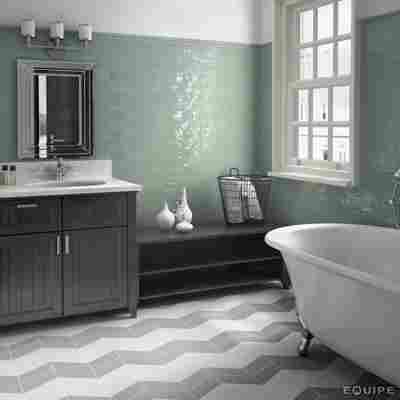Production Costs

Firing Temperature
Porcelain and ceramic tiles are made from clay materials and fired at high temperatures. It's more difficult to reach those higher temperatures (which create a denser, more durable product), so the higher the temperature, the more it adds to the cost.
Some tile lines have both a porcelain floor tile and a ceramic wall tile. The wall tiles are usually less expensive than the floor tiles because it takes less heat to produce them.
Technology
Some companies have more research and technology behind their products than others. They've developed less brittle clay blends that are easier to install, inkjets that print more realistic and natural looking patterns, more durable and freeze/thaw-resistant tiles, and more attractive and versatile materials.
These advances in tile production lead to better products, but these products tend to cost more.
Production Quality
Some tiles are simply made with higher production standards than others. These include:
Better color consistency from batch to batch
Fewer broken pieces and better shipping and packaging quality
More size consistency from tile to tile
Fewer flawed tiles
Higher standards often equal higher prices; it's the difference between a BMW and a Pinto.
Production Location
Where a tile is made and what it takes to get it from there to your home plays a substantial role in how much it costs.
Compare Chinese-made, Italian-made, and American-made tiles. Shipping costs and production standards on a tile from Italy will increase the price, while the low labor and productions costs on Chinese-made tiles keep the prices down. American-made tiles usually have the lowest shipping costs, but higher production costs. All of these factors influence the price to the end user.
Availability
If a tile is stocked locally and in large quantities, it's price will go down. If it has to be ordered in, shipping and handling costs will raise the price of the tile.
For example, we at Tile Lines imported large quantities and numerous sizes of our most popular porcelain line (World Travertine Porcelain) directly from Argentina. As such, we were able to get better pricing, which we passed on to our customers.
A large chain retailer can purchase several hundred thousand square feet of a tile to be distributed to several hundred of their stores. By purchasing such large quantities, only stocking one size of the tile, and not carrying trim pieces, they keep costs down.
But just as good stock and high availability can reduce the cost of a tile, a special order or made-to-order product often costs more than locally-stocked counterparts.








